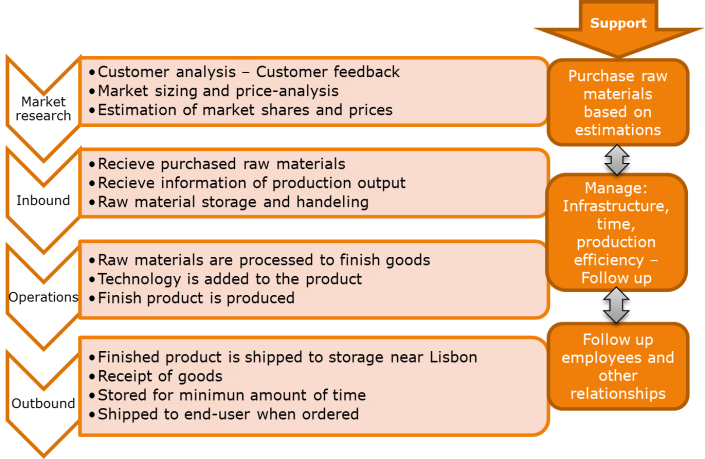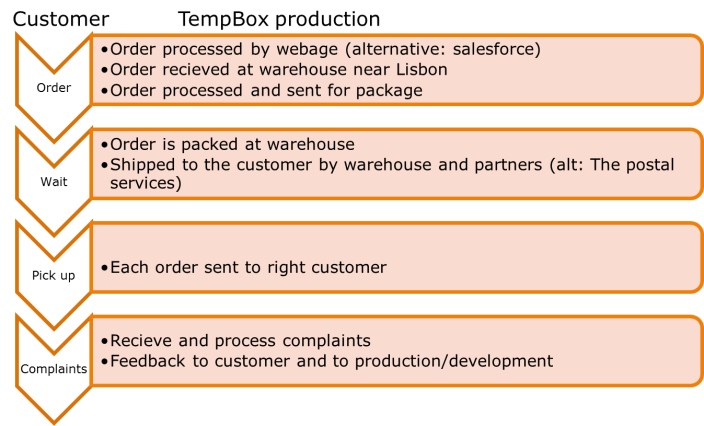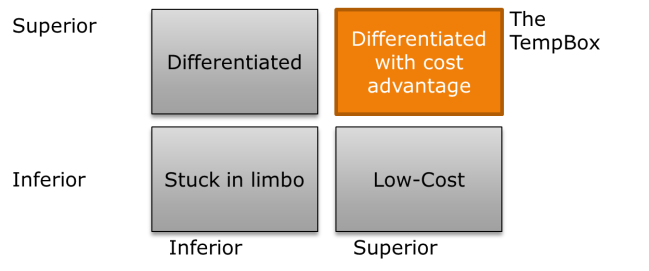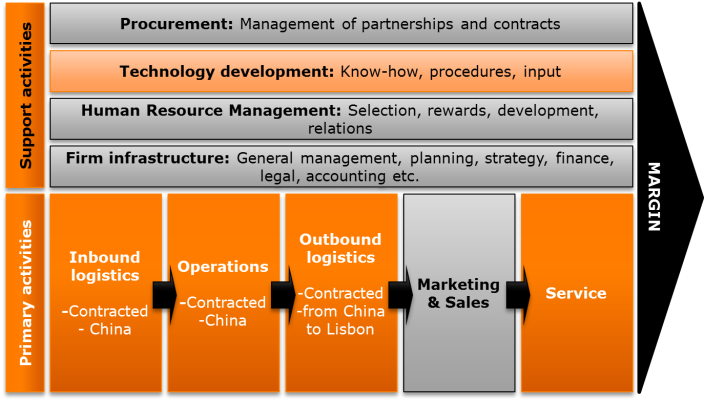Product
The TempBox Processes
TempBox processes
To complement the value chain we have broken it down in details into an overview of the processes that is happening from before we attract a customer to the time of delivery.
These processes are based on what we see ourselves doing the first years before integrating more of the activities vertically.
We do not however use the general value chain process. As we are a startup we have decided to do some changes to the structure in the value chain when it comes to processes.
As you can see we have chosen to have market research as the first element in the process, of course this is a continuous process, however we believe this to be at the very start of the production. Firstly, we are already today testing the market, doing research on it, market sizing, price calculations etc. without having started producing. Secondly, the TempBox, as a start-up, the first thing to figure out – Is there a problem that needs to be solved for the customers out there, and can we actually solve it?
The rest of the processes are rather straight forward and do not need much explanations. However on the right side we chose to add some of the most important support activities in the daily operations.
There is the procurement: purchasing materials for production, the infrastructure in the general which is management of the business like measuring performance indicators in outputs, infrastructure (IT and physical), efficiency, material usage, cycle times (time from order to shipped) etc. And also the human relations, if we want to hire people they need training, feedback, rewards, motivation and so on.
The Customer process
The customer process is broken down into an illustration of the process from ordering to receiving and perceiving the value received.
The value chain of the TempBox
First we want to present our vision and mission (At the time they are not separated as they need to be revised), and our strategic position.
The vision and the mission
«We want to change how people eat on the go – We will give people the freedom of choice, and the ability to save both money and time by providing them a box which keeps the food fresh, and can easily heat it up in several electrical output sockets»
The visions/mission is based (as it should be) on our initial idea of heating food for people on the go. We say we want to change it, not because no-one eats food from a lunch box today, but as we believe people deserve to be able to eat food that is delicious, despite it coming from a lunch box. We will give our customers the freedom of choice to eat whatever, wherever they want, and again of course, heat it up in several sockets!
The strategic perspective
Our strategic position has changed from being low-cost to be a differentiated product – with a patent on the design and alternatively the technology, we will have the ability to take a great market share in the heat-able box industry market. At the same time, as we will come back to, we will over time work for obtaining economics of scale and focus on cost-saving at the same time as we deliver a sleek and stylish functional product with the ability to heat and, customer orientation and warrantee benefits. This is our strategic position:
The value chain:
As we have a tangible product it makes more sense to us to have a value chain. To us, a value chain is the strategic management of cost positioning. The linkages and inter-relationships in the value chain is presented as a flow of activities which can, and will be optimized.
With the value chain, we are decomposing the activities of our firm into strategically important units (Stabell and Fjeldstad 1998). With this tool we can more easily see what is important for the TempBox to focus on in house, and what can and should be out contracted at this time.
We are initially the ones with the idea. We will contract most of our key activities – however our value chain is presented with the primary activities in it. We have done this to illustrate how our value chain looks like when you link all the activities that are contracted out together.
We have made the choice to contract out our key activities as this is consistent with our vision and long term strategic objective – We want to be the idea, the brain behind the project. We want to focus on our core competence which is the ideas, market research, customer orientation, partnership management and management and coordination in the company. When we learn more about the industry, production etc. we might consider demolishing some of the contracts and have logistics and production ourselves. We believe that with learning and time we will be able to take most parts of the value chain in house and operationalize and smooth the process so that it will be less costly than managing and paying for the contracted businesses which we do not control and have to depend on.
This is our resulting value chain, the grey we will do ourselves, the rest we will contract out, mostly to China.
Inbound logistics: material handling and warehousing – We will not do this: contracted. We have sourced materials and productions in China, therefore all raw materials and handling will be dealt with in China. The product will then be shipped to Lisbon via Garland and dealt with in-house.
Operations: transforming material to the final product – outsourced to production companies in China
Outbound logistics: Order processing and distribution – The final product will be storing in an internal warehouse ready to be shipped to the end consumer. Products will enter the warehouse via an IT system, nothing will enter or leave the warehouse without being registered by the system. Products will be boxed by the warehouse and prepared for distribution. Once the product is prepared the delivery to the end consumer will be outsourced to delivery experts UPS or DHL. Outbound logistics will also include supply and demand planning to ensure that stocks are always at the appropriate levels. This will be done in-house by the warehouse manager who will use the IT system and analyse trends and past data to secure the optimal level of inventory.
Marketing services: We will carry out the marketing services ourselves, however as we grow there is a possibility that this could be partly outsourced (i.e. large scale marketing to India). The marketing services involves market research for estimation of demand which we have already estimated for the first year, however it is a continuous process. Here we will generate demand through the use of marketing tools (this process involves creating awareness through internet-based free tools which has already commenced (numbers will come later)), we will manage our channels through this which is closely aligned with partnerships (we will talk about this later). This box is also about communication with clients, refining the product etc. Hence as this part is our core competence together with the management of all partnerships, we will do this ourselves.
The support activities
We will be carrying out the support activities ourselves. This is where our main business lies. Procurement and management of partnerships will be done by us. It will involving liaising closely with supplier to secure appropriate materials at the best costs, we will come back to this point later in the presentation.
Technology is a lighter shade of orange due to the fact that we are not engineers and we have to partly outsource the technology development. However we will play a role in the development and improvements on the product. Through the feedback of our customers, market research, kinks and problems, we will learn and develop the product further.
Cost and value drivers in the value chain
The cost drivers in the value chain of the TempBox are highly linked to the fact that we are contracting out most our business. We do not have scale advantages, but this will highly influence us in the future as we have one product and a very narrow scope, also we will be larger and better. Highly intertwined with scale are the Linkages and Inter-relationship. At the time we do not believe our value configuration to be optimal due to contracting out most of the primary activities.
Reference:
Stabell, C. B. and Ø. D. Fjeldstad (1998). “Configuring value for competitive advantage: on chains, shops, and networks.” Strategic management journal 19(5): 413-437.
The value curves
To understand our product’s position in the competitive marketplace we have done an analysis of the Tempbox’s attributes. We look into which attributes in our Tempbox the customers appreciate the most, and how we are compared to our fiercest competitors. This analysis is called the value curve. Underneath we will present our analysis.
Value curves:
Firstly we will talk a little about the attributes. We chose the attributes based on an analysis of our product benefits, the competitors product benefits, and the customers’ problems. Following, we had a discussion among us based on the information we have been able to retrieve so far in this course in addition to some new information concerning our competitors. The result of the discussion where the attributes we believe to differentiate us from our three main competitors: Compleat, Tupperware and the Indirect competitors (restaurants, cafés, kiosks, and canteens).
We had 15 attributes on the table, but as we should only choose the ones we believe to be most important to our customers, we ended up with nine.
The resulting attributes are: Price, Heat-ability, Multi plug-ability, design, Flexivity, Dish-washer safety, Environmental, Variation in selection of boxes, and Food community. These attributes are developed based on the assumption that these are the ones where we are most different from our main competitors, and which we believe our customer segments emphasize and appreciate.
In the following sections we will describe each attribute and scale them and compare them for us and the competitors.
The Heat-Able Lunch box/ Tempbox:
As we can see from the chart we expect the Heat-Able Lunch Box to be comparatively less preferable regarding price. It will be more expensive due to the technology of heating and plugging, and also the design. As we have the heating and plugging system which we expect to be the major selling points due to the solving of important customer issues, we score the highest on these. We have plans for the design to be sleek and stylish and fit our customers’ needs and expectations. In our opinion the need for a lunch box to be dish-washer safe is an important attribute, hence ours will be. Further we are not confident yet that we are able to make the material sustainable and we are not planning on making several selection variations of the lunch-box. However, we are planning on making a community around the box. There will be an internet web-page to sign up to where the customers will find recipes for suitable lunch box meals, the opportunity to cooperate on making the food if working at the same place, forums for feedback on the product, customer service etc.
Competitors:
Compleat:
Compleat is the company which sells lunch boxes like Foodskin, Foodbag, Gourmet etc. These are boxes which have really neat designs for every need. They are mostly flexible, environmental and Compleat delivers a broad range of products for different needs. They also claim to have the world’s most flexible lunchbox. They are comparatively expensive, but will probably have a lower price than us. They do not have a food community surrounding their products.
Heat-Able vs. Compleat:
Tupperware:
Tupperware is a solid brand most people know. They make everything from potato peelers to boxes to different uses. In their assortment they also have lunch boxes. As we noticed after making the chart on Tupperware they have some few advantages compared to us which is of course the brand name, but when coming to the attributes: price and variation.
Heat-able vs. Tupperware
Indirect (Restaurants, cafes, kiosk, canteens etc).
In this value curve analysis we faced some problems. Restaurants and similar places are not directly comparable to the heat-able lunch box. However, we will use the same attributes for comparison reasons, and then we will explain the line of thought.
As we can see from the red line the indirect competitors score quite high on many attributes. However they also have a few disadvantages. In addition to the more expensive service, the are often not so attractive on “design” like the appearance of canteens and kiosks, and on the environmental side. In addition, not shown by this chart is the inconvenience presented by waiting time for the food or in lines, and the reduced opportunity to self-selection. For the attribute regarding heating we have given them the highest score due to the food being prepared at the purchasing time. Plug-ability is rather low due to the inconvenience of having to leave your car, work-place, the building etc. to get access to warm food. High scores are given to flexivity, dish washer, and variation due to respectively not having to carry and prepare food in a box, no need to dish wash and the variety surrounding a work-place can be quite extensive if one have time to go there.
The concluding curves:
In conclusion
To conclude we see that the Tempbox is fairly good positioned in the market compared to the competitors. Our main strengths are the attributes linked to the innovative function of being able to heat the food. The other attributes like sleek and stylish design and the flexibility are attributes we score high on, but relative to the competitors they are not too impressive. Our main weakness is the price aspects. However, we believe the ability to heat and plug will offset the higher price.
Creating the Landing Pages
For the past two weeks we have focused on creating our landing pages, as a group we were pretty excited to begin them. First of all we read over the slides of last week’s class to ensure that we had in our mind exactly what needed to be done. We are using our landing pages to test the value proposition and to guarantee that there will be interest in our product. To do this we have created three landing pages that the group members have posted to Facebook, in hope of acquiring the 200 views needed (we’ll let you know how this goes later!). Once our landing pages have been public long enough to gain sufficient views, we will carry out A/B testing to see which is best.
The most important part of the landing page to grab the viewers attention is a strong headline, so this is what we focused on first. We decided to use the products name “The Tempbox”, this is simple but effective, as the viewer becomes intrigued and wants to learn more. We then used the secondary headline to explain further as to what the Tempbox is – it is “The easiest way to eat food on the go”. We used two separate landing page creators (Launchrock and my Instapage) as we encountered problems with using the same website to create two pages for free, therefore the overall design of each page differs slightly. For the landing page created with Launchrock we had already said “The easiest way to eat food on the go” therefore we took the opportunity to use the secondary headline to place three adjectives that we thought best described the Tempbox “Conevenient, Fresh, Fast”. At first we created one page on both Instapage and Launchrock but after seeing that we could not add important details, such as trust indicators to the Launchrock page, we decided to give in and go back to Instapage to create a third landing page. This used a similar background to the second landing page but incorporated important aspects that were missing in the individual.
In the first and third landing page, we placed trust indicators, in the form of partner validation e.g. Quality Control, USB, at the bottom of the page to build trust and credibility of the product. We also provided technical details about that product, showing the clear benefits that our product holds over competitors.
For the offer section, we took the most important aspects of the elevator pitch, making it even more concise, and placed it “above the fold” because the message is important in informing the viewer as to what the Tempbox is. All landing pages used the same offer as this is something that cannot easily be changed, the Tempbox will always allow you to “Enjoy the freedom of choice to eat whatever you want, wherever you want. Simply plug the Tempbox into any plug, USB socket or car cigarette lighter to heat your meal of choice. Its flexible design allows you to neatly pack it away into even the fullest of handbags and backpacks.”
We spent a long time as a group searching for suitable backgrounds that we thought would draw the viewers attention, we ended up deciding to use food images for each background, as we do not have a prototype and did not feel it was appropriate to take an image of a lunchbox from the web. We experimented with the colours, deciding upon which colour scheme fitted the background best, but also what the viewer might associate each colour with. In the second landing page, we ruled out both green (it looked sickly and unappealing!) and blue (because it made the landing page look too busy with so many colours), before deciding upon orange.
Basically, we experimented with different landing page creators and the varying page designs each creator enabled you to choose all afternoon. Then once we had decided upon these, we created our landing pages in no time at all!
Now all we have to do is wait for the viewers to roll in! (And shamelessly promote the pages on Facebook in hope of receiving 200 hits)
SWOT analysis – Revised
The SWOT (Strengths, Weaknesses, Opportunities, and Threats) analysis is a simple, however efficient tool to evaluate own internal strengths and weaknesses in addition to evaluating external opportunities and threats.
Please leave a comment for us if something is unclear or if you have other suggestions. We are Lean Explorers and are highly open to changes!
The old version:
The Elevator Pitch
The Tempbox Elevator Pitch!
“Tempbox helps people on the move, such as, workers and students solve their lunch-time problems by providing them with the freedom of choice to eat whatever they want, wherever they want.
Tempbox provides a convenient, economical and, if you like, healthy alternative to dining out at fast food outlets or restaurants. It is also better than the traditional lunchbox because with the Tempbox your food will stay fresh until it is time to ‘be temped’, enabling you to eat any meal; hot or cold, simply by plugging the Tempbox into any plug, USB socket or car cigarette lighter to heat your meal of choice. And once you have finished with your Tempbox for the day, its flexible design allows you to neatly pack it away into even the fullest of handbags and backpacks.”
Our idea decision making process
In session 1 we were provided with means of inspiration to be able to come up with ideas for a startup and a tool for evaluating different ideas. After class all team members did some thinking and we were able to come up with a variety of ideas:
- Motorbike Taxi Service
- All training app
- Self-charging solar panel headphones
- Container recycling to build affordable and environmental houses
- App for freelancing services (sell and buy)
- App for world’s smoothest traveling connections
- The heat -able lunch box
We decided to evaluate them by first asking: Does this idea solve a customer problem? Will people see the use of this product/service? Will they buy it?
After getting an overview over the members’ thoughts and comments on these questions, we ran the ideas through these criteria:
We gave the ideas points and concluded on “The heat-able lunch box”. It got a score of 19. The scores were high on Doable, Bootstrapping, scaleability, potentially global, usage of internet as channel. The scores were lower on disruption, innovation and if it would go viral.
In retrospect we are really pleased with our idea. We believe it to meet a need which has been unsolved up untill now.
Stay tuned for the development of this amazing product by this even more amazing team!
















